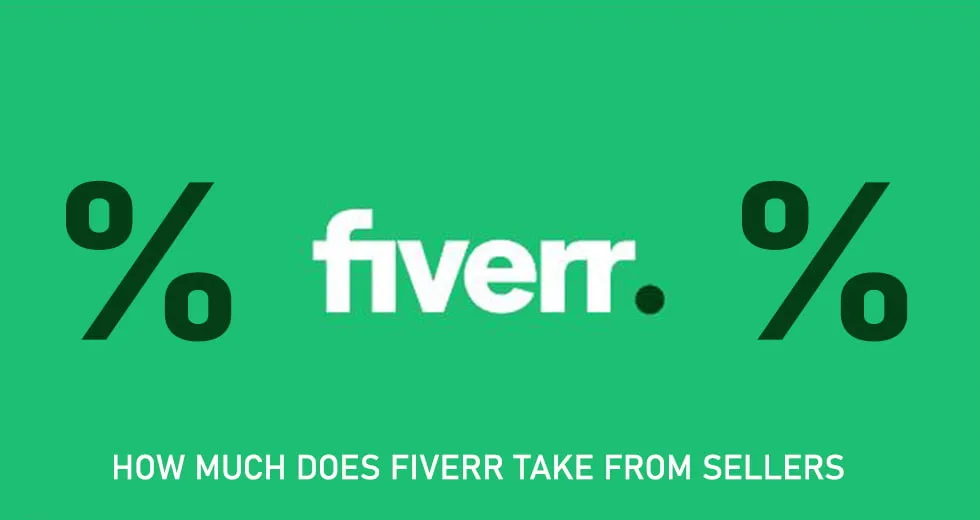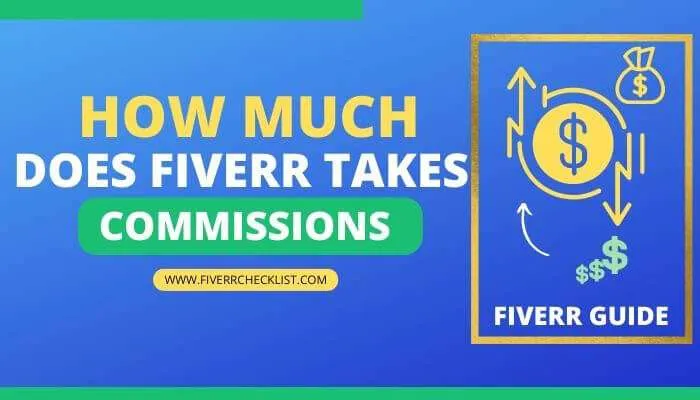Welcome to the world of Fiverr! If you're dipping your toes into freelancing or just curious about how things work on this popular platform, you might be wondering, "How much does Fiverr actually take from sellers?" Well, you're in the right place! In this blog post, we’ll break down Fiverr's fee structure to give you a clearer picture of how it affects your earnings and what you can expect when you sell your services. Let's dive in!
Understanding Fiverr's Fee Structure

When you sell services on Fiverr, you might quickly notice that the platform does come with its own set of fees. Understanding this fee structure is crucial for maximizing your profits and adjusting your pricing strategies effectively. Let’s break it down in a simple way.
Fiverr operates on a commission-based system, meaning that the company takes a cut from each transaction. Here’s how it typically works:
- Service Fees: Fiverr takes a standard 20% fee from the total amount you earn on each gig. So, for instance, if you charge $100 for a service, you’ll receive $80 in your pocket after Fiverr's cut.
- Payment Processing Fees: In addition to the service fee, Fiverr also has payment processing fees that can vary based on how the customers choose to pay. Generally, these fees are around 2-3%.
- Currency Conversion Fees: If you’re operating in a different currency than your client's payment currency, Fiverr charges conversion fees. This is usually a small percentage, but it’s essential to keep this in mind.
Let’s summarize Fiverr's fee structure in a quick table:
| Fee Type | Percentage/Value |
|---|---|
| Service Fee | 20% of total earnings |
| Payment Processing Fee | Approximately 2-3% |
| Currency Conversion Fee | Varies (usually a small percentage) |
It’s essential to factor these fees into your pricing when creating your gigs. Knowing how much Fiverr takes will help you make informed decisions, ensuring that you’re optimizing your earnings while still offering competitive prices to your clients. Understanding Fiverr’s fee structure can empower you as a seller, so you can focus more on what you do best!
Also Read This: Can You Deliver Multiple Files When Delivering a Fiverr File?
Types of Fees on Fiverr

When you decide to sell your services on Fiverr, understanding the fee structure is crucial. Fiverr has a few different types of fees that might apply to your sales, and knowing about them can help you plan your pricing strategies effectively.
Here’s a breakdown of the primary fees you might encounter as a seller:
- Service Fee: Fiverr charges a flat 20% service fee on every transaction. This means that if you sell a gig for $100, you’ll receive $80 after Fiverr takes its cut. This is the main fee sellers should be aware of.
- Withdrawal Fees: When you're ready to withdraw your earnings from Fiverr, there may be additional fees depending on your chosen withdrawal method. For example:
- Currency Conversion Fee: If you’re selling in a different currency, Fiverr may charge a conversion fee, typically around 2%.
| Withdrawal Method | Fee |
|---|---|
| PayPal | No fee for transfers above $1 |
| Direct Deposit via Fiverr Revenue Card | Varies based on your bank |
Being aware of these fees can help you better navigate the platform and set your prices appropriately. After all, it’s vital to ensure you’re making the most of your hard-earned money!
Also Read This: Best 10 Fiverr Gigs for SEO Services in 2024
Impact of Fees on Seller Earnings

Now that we know the types of fees Fiverr imposes, let's discuss how these fees affect your overall earnings. Many new sellers might overlook this aspect, but it's essential to understand how Fiverr's fees can impact your take-home pay.
For instance, let’s say you’re selling a gig for $200. After Fiverr’s service fee, you’re left with:
- 200 - (20% of 200) = 200 - 40 = $160
This means you'll receive $160 from that sale. But wait, it doesn’t stop there. If you choose to withdraw your funds via a specific method, you may face additional withdrawal fees. So, your earnings could dwindle even further.
Here’s an example to visualize the total impact:
- Original Sale Price: $200
- Fiverr Service Fee (20%): -$40
- Withdrawal Fee (e.g., PayPal): Consider a typical $1 withdrawal fee
- Currency Conversion Fee (if applicable): Say 2% of the remaining amount is $3.20
- Your Final Earnings: $200 - $40 - $1 - $3.20 = $155.80
As you can see, understanding how these fees stack up is vital for maximizing your income on Fiverr. Always keep these factors in mind when pricing your services, as every dollar counts!
Also Read This: What Freelance Paralegals Charge and Earn
Comparing Fiverr Fees to Other Freelance Platforms

When hopping onto the freelance bandwagon, it’s essential to know how Fiverr stacks up against its competition regarding fees. Many freelancers wonder: Is Fiverr worth it? To answer that, let’s compare it with other popular platforms like Upwork and Freelancer.com.
| Platform | Commission Rate | Withdrawal Fees | Payment Processing Fees |
|---|---|---|---|
| Fiverr | 20% on all sales | $1 per withdrawal | No additional fees |
| Upwork | 5-20% (based on earnings) | Varies by method | Up to 3% on payments |
| Freelancer.com | 10-20% (based on project) | Variable | 3% of payments |
As noted in the comparison above, Fiverr’s commission is flat at 20%, which can be steep, especially for new sellers. In contrast, Upwork uses a sliding scale where the percentage decreases with higher earnings, making it potentially more lucrative for long-term freelancers. Freelancer.com also varies its rates, which means you could save money there depending on your project.
Ultimately, choosing the right platform hinges on personal preferences. If you’re after quick projects or side gigs, Fiverr’s model might suit you just fine. However, for ongoing relationships or larger contracts, considering the tiered rates from Upwork could lead to better rewards as you build your freelance business.
Also Read This: Is It Safe to Login on Fiverr? Hereâs What You Need to Know
Tips for Maximizing Earnings on Fiverr
If you’re looking to make the most out of your Fiverr experience, you’re in the right place! Below are some tried-and-true tips that will help you maximize your earnings and grow your presence on the platform:
- Optimize Your Profile: Make sure your profile is fully completed with a professional photo, compelling bio, and examples of your work. This will help you stand out.
- Create Multiple Gigs: Don’t limit yourself to just one gig. Offer different services or variations of your primary service to attract a wider audience.
- Utilize SEO: Use relevant keywords in your gig title and description to improve visibility. Think about what potential buyers are searching for.
- Deliver High-Quality Work: Always strive to exceed buyer expectations. Happy customers are more likely to leave positive reviews and return for future projects.
- Engage with Buyers: Communicate promptly and professionally with clients. This builds trust and often results in more repeat business.
- Promote Your Gigs: Don’t rely solely on Fiverr’s internal traffic. Share your gigs on social media or other freelancing forums for more exposure.
By following these tips, you can carve out a successful niche for yourself on Fiverr. Over time, with patience and dedication, your earnings can start to reflect the effort you put into maximizing your listings. Remember, every little bit helps, and the right strategies can lead to big results!
Also Read This: Understanding Commercial Use on Fiverr: What Does It Mean?
7. Frequently Asked Questions
When it comes to using Fiverr as a seller, potential questions often pop into the minds of newcomers. Let’s delve into some of the most frequently asked questions that can help clarify the ins and outs of selling on this platform.
- What percentage does Fiverr take from sellers?
Fiverr typically takes a 20% commission from each transaction. This means that if you sell a service for $100, you’ll receive $80 after Fiverr takes its cut. It’s essential to factor this into your pricing strategy.
- Why does Fiverr take such a high commission?
The commission helps maintain the platform, covering things like marketing, website maintenance, and customer support. This allows sellers to focus on delivering top-notch services without worrying about the backend logistics.
- Are there any additional fees?
Besides the standard commission, there are no hidden charges for sellers unless you opt for premium features or promotions. However, keep in mind that payment processing fees might also come into play depending on the payout method you choose.
- Can I increase my prices to offset Fiverr's commission?
Absolutely! Many sellers choose to set their prices higher to maintain their desired income after commission fees. Just ensure that your pricing reflects the perceived value of your services.
- How can I maximize my earnings on Fiverr?
To increase your earnings, focus on delivering exceptional quality, gaining positive reviews, and promoting your services outside of Fiverr through social media or a personal website. Additionally, consider offering packages or add-ons to enhance your offering.
8. Conclusion
In summary, selling on Fiverr can be a rewarding venture, but it's crucial to understand the financial implications involved. With Fiverr taking a 20% commission, you’ll need to be strategic about how you price your services and manage your expenses. Despite the commission, many sellers find that the platform provides valuable exposure and a ready-made audience, which can more than compensate for the fees.
When navigating the seller experience, remember these key points:
- Factor in Fiverr's commission when setting prices to ensure you’re still earning what you need.
- Utilize Fiverr's tools for promoting and upgrading your gigs to stand out in a crowded marketplace.
- Engage with clients and offer outstanding service to build a loyal customer base and earn positive reviews.
Ultimately, like any business model, success on Fiverr isn’t just about the fees; it’s about offering value, promoting efficiently, and adapting your strategies to fit your unique services. Happy selling!



